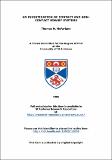An investigation of contact and non-contact binary systems
Abstract
Spectroscopic and photometric observations of six late-type contact and near-contact binaries are presented, and the results of the analyses discussed. Absolute dimensions have been deduced for three systems: YY Ceti. CX Aquarii and RV Corvi.
YY Ceti, which has an orbital period of 0.79 days, is found to be composed of a normal main-sequence star of spectral type A8 and an evolved G-type star which completely fills its Roche lobe. We argue that the system will evolve into contact within approximately 10 9 years, either by the nuclear evolution of the primary component, or by the loss of angular momentum via magnetic braking. We also propose that this may represent a route to the A-type contact binaries which does not involve a passage through the W-type phase.
The binary CX Aquarii, which has an orbital period of 0.56 days is found to have a similar configuration to YY Ceti, except that its primary component is a main-sequence star of spectral type F5 with an evolved companion of spectral type G9. We argue that the system should achieve contact by loss of angular momentum via magnetic braking within approximately 108 years if the
atmosphere of the primary component is convective, or within approximately 5 x 108 years if the primary possesses a radiative atmosphere.
RV Corvi is found to consist of an unevolved F2 primary component with a K-type companion which has a much larger radius and luminosity than expected for its mass. The system has an orbital period of 0.75 days. Although the binary may be semi-detached, with the primary component completely filling its Roche lobe, it is most probably in a state of marginal contact. In order to obtain a solution to the photometric data it was necessary to treat the secondary component albedo as a free parameter, yielding a value greater than unity. This result implies that there is an abnormal distribution of luminosity on the surface of the binary, which may be interpreted either as an excess of light on the facing hemisphere of one or both of the components, or as a deficit of light on the averted hemisphere of the secondary.
The three remaining binaries, EZ Hydrae, AD Phoenicis and RS Columbae, were all identified as contact systems: EZ Hydrae as a W-type system of orbital period 0.45 days, AD Phoenicis as an A-type system of period 0.38 days, and RS Columbae as an A-type system with a period of 0 .67 days. Although a value for the mass ratio of EZ Hydrae had been obtained from spectroscopic observations, no photometric solution could found because of severe 'disturbances' in its light curve. From our sample of six systems, AD llioenicis and RS Columbae were the only two for which there were no spectroscopic observations. Although photometric solutions were obtained for both systems, these were very insensitive to the value of mass ratio,
which tended toward the physically unrealistic value of unity.
The results for YY Ceti, CX Aquarii and RV Corvi are combined with the published masses, radii and luminosities of 21 other contact and near-contact binaries. It is shown that the primary
components of all contact and near-contact systems are normal main-sequence stars with radii and luminosities appropriate to their masses. The secondary components of the B-type systems and the W-type systems are all overluminous for their masses, due mostly to the radii being increased by a factor of ~1.7. However, these secondary components are segregated on the H-R diagram, where the W-type secondaries appear to the left of the main sequence band due to luminosity transfer from the primary components. The secondary components of the A-type contact systems all have radii and luminosities substantially larger than expected for their masses.
Type
Thesis, PhD Doctor of Philosophy
Collections
Items in the St Andrews Research Repository are protected by copyright, with all rights reserved, unless otherwise indicated.

